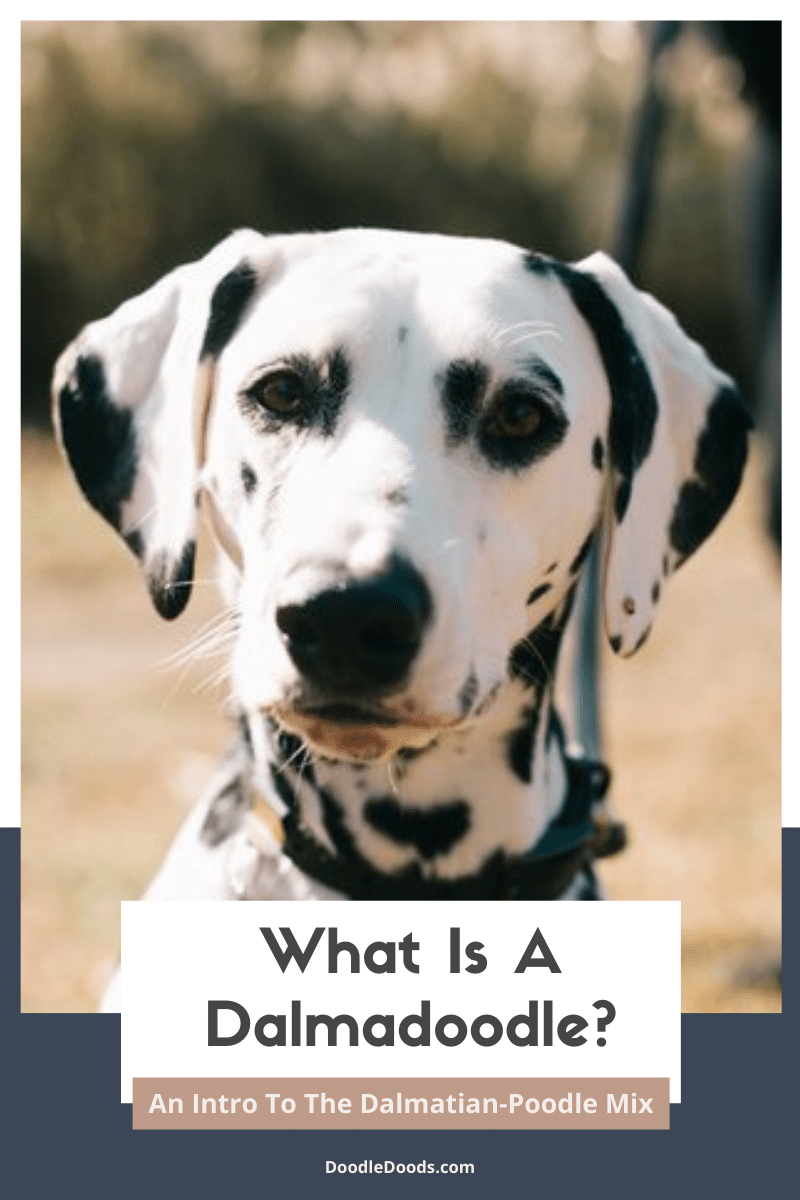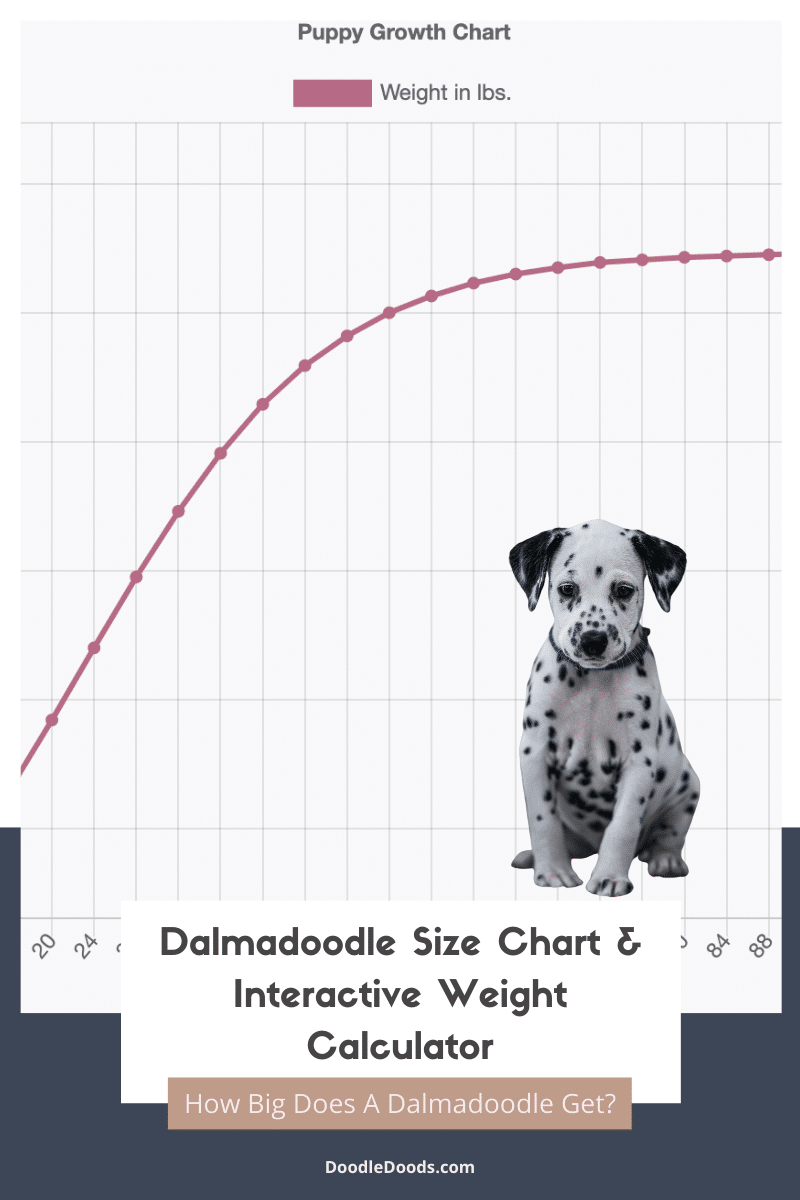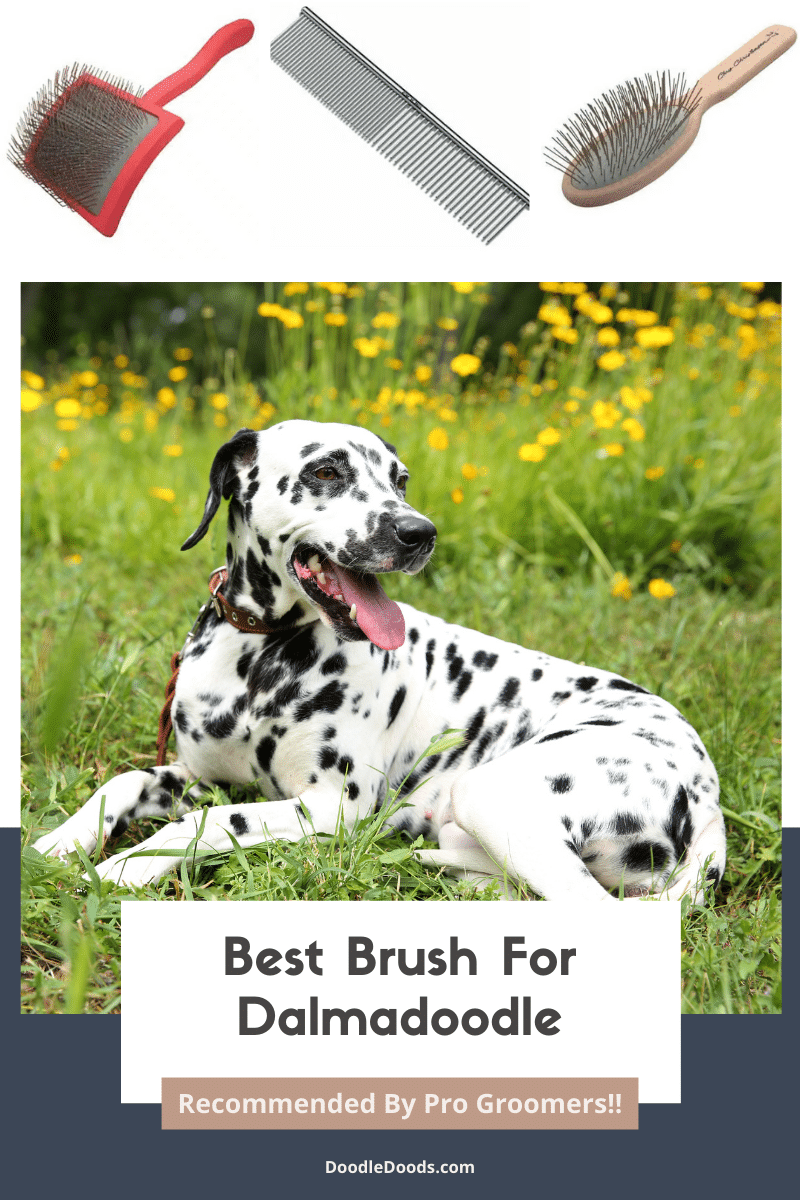Dalmadoodle, Dalmapoo, whatever you like to call them, all goes! The Dalmatian-Poodle mix is one of the newer designer breeds that’s taking the whole world by storm. In this article, you’ll learn all about the Dalmadoodle, including what they look like, how big they get, what their grooming and exercise requirements are, and so much more. Keep on reading to learn more!
Table of Contents
- What Is A Dalmadoodle?
- Physical Appearance
- Dalmadoodle Pictures (Puppy & Adult)
- Dalmadoodle Size
- Variations & Generations
- Personality & Temperament
- Dalmadoodle Health
- Dalmadoodle Exercise Requirements
- Training A Dalmadoodle
- Coat Care & Grooming
- Where Can You Get Dalmadoodle Puppies?
- Dalmadoodle: FAQ
What Is A Dalmadoodle?
The Dalmadoodle is a hybrid cross between the Dalmatian and Poodle. Intelligent, affectionate, athletic, and insanely adorable, these dogs combine the best traits from both sides of their lineage. Bred for their low-shedding and hypoallergenic coats, these pups often inherit the Dalmatian’s spotty coat.
There’s probably not a single person on this earth who doesn’t recognize a Dalmatian by its signature black and white, polka-dotted coat. Of course, the Poodle is no stranger to us either with its fabulous hairdos and adorable looks. But even though both the Dalmatian and Poodle are so popular and well-known, the Dalmadoodle crossbreed is still one of the newer, up and coming Poodle mixes out there.
As with most Poodle mixes, Dalmadoodles are an excellent choice for people who are looking for a pet that doesn’t trigger allergies or shed much hair. We have the Poodle genes to thank here!
On the other hand, the Dalmatian and Poodle are very different purebreds. This means that a Dalmadoodle can end up in a variety of ways. And that’s exactly what we’re going to delve into in this guide, so you know exactly what to expect with this amazing hybrid breed.
Physical Appearance
Dalmadoodles combine the traits of both the Poodle and Dalmatian. They’re medium to large sized dogs with an athletic build. They often come with fluffy coats that are curly or wavy, often with the spotty pattern as the Dalmatian. They usually have floppy ears and a longer muzzle.
Colors
Dalmadoodles may come in a variety of coat colors and patterns, but they usually inherit the Dalmatian’s spotty coat. However, they can also come in many other colors and patterns, such as the ones seen in both Poodles and Dalmatians.
Even though Dalmatians are most known for their black and white spotty coats, there’s actually much more variety within purebred Dalmatians! True, their coats are usually polka-dotted, but they don’t necessarily have to have the black and white spotted coat. Dalmatians may also have white and liver brown spotted coats, white and orange, and white and lemon coats. Moreover, some Dalmatians have tri-colored coats of white, black and tan, or white, liver, and tan.
The Poodle also comes in many different coat colors and patterns, most commonly they have solid coats like brown, black, silver and gray, cream, apricot, red, cafe au lait, and white. They can also sport two-toned coats and patterned coats.
At the end of the day, it all boils down to a Dalmadoodle’s genetic makeup and what color coats their parents have. By the way, many ethical breeders also conduct coat testing of their breeding dogs to breed for certain coat colors and patterns.
Coat, Shedding, & Hypoallergenic Level
Most commonly, Dalmadoodles come with low-shedding curly or wavy coats, but sometimes they may lean more on the Dalmatian’s side with a straighter coat. A Dalmadoodle’s coat is usually shaggy and fluffy, but their hair texture can vary quite significantly. Again, this is dependent on their genetics and how much they take from each side of their lineage.
When it comes to any Doodle’s coat and their potential for shedding, we have to look at their heritage. Poodles are considered hypoallergenic dogs because of their single-layered coats and curly hair. In fact, the very first Doodles were created to achieve low-shedding, hypoallergenic dogs, as the Poodle’s genes can significantly reduce the potential for shedding.
On the opposite side we have the Dalmatian that’s also a single-coated breed. However, Dalmatians are known to be quite heavy shedders still, which means that not all Dalmadoodles are as allergy-friendly as you’d initially think.
Generally, the most hypoallergenic and least shedding of them all is the curly coat, mostly inherited from the Poodle. The only thing to note with curly-coated Dalmadoodles, however, is that they’re also the most high-maintenance and require the most grooming out of all three coat types.
The wavy coat sits somewhere in between with its more relaxed texture. They’re still quite allergy-friendly and they’re also less prone to matting when compared to the curly coat. Lastly, the straight coat leans more on the Dalmatian’s side of the lineage, meaning that they may also shed slightly more than the other two coat types.
Genetic testing can also be a helpful guide here, as many reputable breeders test their breeding dogs for coat genetics and curling. This helps ethical breeders produce certain coat types and increase the potential of the puppies inheriting low-shedding coats.
Dalmadoodle Pictures (Puppy & Adult)
Enough about *talking* how the Dalmadoodle looks like. It’s time you see this with your very own eyes:
| Black & White Dalmadoodle | @dalmadoodle |
| Black & Gray Dalmadoodle | @blue.the.dalmadoodle |
Dalmadoodle Size
The Dalmadoodle is a medium to large-sized dog with an athletic build. Their weight can range between 20 and 70 pounds, and their height between 15 and 23 inches, depending on the size of Poodle used in the mix.
For the Dalmatian-Poodle mix, the most common varieties are the Standard and Miniature Poodle. Once the Dalmadoodle becomes a more established hybrid breed, we can also expect breeders to introduce the smallest Toy Poodles into the mix to achieve even tinier little Doods.
Here’s a helpful Dalmadoodle size chart that’ll help you understand the difference between Standard and Mini Dalmadoodles:
| Mini Dalmadoodle | Standard Dalmadoodle | |
| Weight | 20-40 pounds | 40-70 pounds |
| Height | 15-19 inches | 20-24 inches |
| When Full-Grown? | 11-13 months | 12-16 months |
*A dog’s height is measured from the withers, which is the highest part of their shoulder blades.
Predicting a Dalmadoodle’s full-grown size can get tricky, especially considering that both Dalmatians and Poodles can significantly vary in size. The purebred Dalmatian can weigh anywhere from 45 and up 70 pounds. They usually stand about 19 to 24 inches tall at the shoulder.
Meanwhile, the Poodle comes in three different sizes: Standard, Miniature, and Toy Poodle. The largest of them all – the Standard Poodle – is quite similar to the Dalmatian with its 38 to 70 pound weight and height of around 24 to 27 inches. Miniature and Toy Poodles are considerably smaller, the former weighing around 10 to 20 pounds with a height of 10 to 25 inches, and the latter weighing just 4 to 12 pounds with a height that stays below 10 inches.
Variations & Generations
Another factor that can affect the Dalmadoodle’s size, coat type, and allergy-friendliness is their generation. With crossbreeds, there are numerous ways to breed a litter of puppies. To simplify the process, all of these variations are called generations.
The very first generation Dalmadoodle, also known as the F1 Dalmadoodle, is the direct result of crossing a purebred Dalmatian to a purebred Poodle. Then there are backcross generations like the first-generation backcross (F1b) Dalmadoodle that’s created by crossing an F1 Dalmadoodle back to a Poodle. This will already tell us that the Poodle’s genetics are likely in the majority in this generation.
As the Dalmatian-Poodle crossbreed is still quite new and rare, they’re most commonly bred as first-generation Doods. But we’re eagerly looking forward to seeing more variations of this adorable hybrid breed, such as the ones below:
| 1st Parent | 2nd Parent | % Dalmatian* | % Poodle* | |
| F1 Dalmadoodle (first-generation) | Dalmatian | Poodle | 50% | 50% |
| F1B Dalmadoodle (first-generation backcross) | F1 Dalmadoodle | Poodle | 25% | 75% |
| F1BB Dalmadoodle (first-generation backcross backcross) | F1B Dalmadoodle | Poodle | 12.5% | 87.5% |
| F2 Dalmadoodle (second-generation) | F1 Dalmadoodle | F1 Dalmadoodle | 50% | 50% |
| F2B Dalmadoodle (second-generation backcross) | F1 Dalmadoodle | F1B Dalmadoodle | 37.5% | 62.5% |
| F2B Dalmadoodle (alternate cross) | F2 Dalmadoodle | Poodle | 25% | 75% |
| F3 / Multigen Dalmadoodle | F1B Dalmadoodle or higher | F1B Dalmadoodle or higher | Varies | Varies |
*These are generic calculations only – genetics are rarely mathematically accurate.

Personality & Temperament
Dalmadoodles are active, intelligent, playful, and super affectionate dogs. Both Poodles and Dalmatians are smart, energetic, and loving breeds, and the Dalmadoodle will inherit all of those amazing traits. Thanks to their high levels of intelligence, they’re generally easy to train. However, they might be a bit stubborn throughout the process – just a word of caution!
What makes the Dalmadoodle so special is how goofy and entertaining they can be! It sometimes seems as if they have endless amounts of energy to spend and they’ll gladly join you on all sorts of fun workouts.
These Doods are also very loyal to their owners and they tend to form strong bonds with their favorite humans. They adore their human parents and they can’t get enough of spending time with you. But with dogs like this you’ve got to remember that they can also be prone to separation anxiety. Dalmadoodles don’t tolerate being alone for long hours, so these Doods are best suited for people who either work from home or can hire someone to spend some time with their dog during the day.
Another important thing to consider with Dalmadoodles is that they can get protective and be wary of strangers. The occasional bark isn’t uncommon when they encounter someone they haven’t met before. Still, with proper socialization and training, this shouldn’t be much of a problem.
Dalmadoodle Health
Dalmadoodles are generally healthy dogs, but they can be prone to health conditions like hip and elbow dysplasia, Addison’s Disease, Cushing’s Disease, deafness, gastric dilation volvulus (GDV, a.k.a bloat), certain eye diseases, and deafness. Minor health concerns in Dalmadoodles include ear infections, skin problems, and food allergies.
The more serious health conditions can be minimized with proper genetic testing and health screening of the breeding dogs. Essentially, reputable breeders will only add extensively tested parent dogs into their breeding programs to ensure that their puppies are as healthy as possible.
By the way, crossbreeds like the Dalmadoodle often benefit from hybrid vigor. This means that hybrid breeds are less prone to genetic conditions that are common in their purebred parents. And it’s all thanks to their more diverse genetic makeup!
With minor conditions like ear infections or food allergies, certain lifestyle changes can make a world of difference. For instance, ear infections can be prevented with proper ear hygiene.
Food allergies and skin conditions can usually be managed by using only products that your Dood tolerates. For example, if your Dalmadoodle is allergic to chicken in their food, switch their kibble to a chicken-free formula instead. Likewise, if your pup is suffering from skin allergies or coat issues like excessive shedding and itchiness, switching their shampoo and conditioner for hypoallergenic products could potentially help.
All in all, to keep your Dalmadoodle healthy and happy you’ve got to make sure that all of their needs are met. Feed your Dood a healthy and balanced diet, make sure they get plenty of exercise, stay on top of their grooming routine, prevent any unnecessary stress, and your pup will enjoy a happy and fulfilled life for many years by your side.
Dalmadoodle Lifespan
The Dalmadoodle’s lifespan can range between 11 and 15 years. As it’s often the case with dogs, smaller Dalmadoodles usually outlive their larger counterparts by a few years. Therefore, we can expect smaller Mini Dalmadoodles to live about 13 to 15 years, sometimes even longer than that. In contrast, larger Standard Dalmadoodles may have a slightly shorter life expectancy of about 11 to 13 years.
Dalmadoodle Exercise Requirements
Dalmadoodles are high energy dogs, which means that they need lots and lots of exercise every day to stay healthy, happy, and fit. About 90 minutes of exercise per day is a must for these dogs, even two hours if your dog is particularly energetic.
Usually, larger Standard Dalmadoodles require more exercise, whereas smaller Mini Dalmadoodles could also do well on 60 minutes per day. After all, both Poodles and Dalmatians love getting their workouts in! Vigorous exercise is what these dogs thrive on.
Twice a day walks, some jogging and hiking, swimming, and playing around in the backyard will all be perfect exercises for your active pooch. Don’t forget to schedule in some fun play sessions with interactive toys or even playing fetch with your Dood.
Speaking of which, mental stimulation is just as important for Dalmadoodles as physical exercise. The goal of providing plenty of mental and physical stimulation for your dog is to let them exert all that pent up energy. Otherwise, you might soon notice how your backyard has been all dug up, your furniture has been completely destroyed, or that your pup won’t stop behaving badly. All of these destructive behaviors stem from boredom and inadequate stimulation!
Physical exercise accounts for anything that gets your pup’s body moving. For mental enrichment, make sure your dog has plenty of chew toys and puzzle toys to play with. Play games that lets your pooch use its smart brain and don’t forget to keep up with daily training sessions as well.
Training A Dalmadoodle
Thanks to their super intelligent parents, Dalmadoodles are smart dogs that are easily trainable. These dogs love learning new tricks and their alertness should make the process rather smooth. Needless to say, only use positive reinforcement training methods – yelling and scolding your dog won’t get you far! Nor is it healthy for your dog’s emotional wellbeing and your relationship.
The easiest way to raise your Dalmadoodle puppy into a well-rounded and well-behaved adult is to start socializing and training your pup from an early age. One of the most important factors is early socialization, as this will teach your Dood how to appropriately interact with other people and pets outside of the household. Socialization also helps to prevent fear-based aggression and anxiety later down the line.
When it comes to training, establishing a good routine and setting boundaries from the moment you bring your puppy home will go a long way. The sooner you start with potty training, obedience training, and crate training, the easier it will be for your pup to pick up on desired behaviors and habits. Of course, make sure you always have tasty treats at hand to reward your Dood for good behavior!
With Dalmadoodles, patience and consistency will be key. Some dogs are more stubborn than others, especially during the adolescence stage in their puppyhood. So, make sure that you’re keeping up with your training schedule and set a good example for your puppy.
Enroll In An Online Puppy School
One of our absolute favorite programs for Doodles is the Online Puppy School by Baxter & Bella. What makes this online puppy school so great is that for a one-time subscription fee, you’ll get lifetime access to their countless resources on all things related to raising a dog. Whether you need help with potty training or leash walking, or if you’re struggling with certain behavioral issues, this program has got you covered.
With this program, you’ll be the one teaching your dog all of those desired behaviors and habits. This is an excellent way to build a strong bond with your puppy! Not only that, you can also follow the program at your own pace in your own home – a familiar environment for your pooch can take a lot of pressure off of them.
Keep in mind, however, that an online puppy school won’t provide that much-needed socialization aspect for your puppy as in-person training classes do. So, make sure to safely socialize your puppy with other pets and people of all ages once they’ve been fully vaccinated.
Coat Care & Grooming
Dalmadoodles need to be groomed regularly to prevent matting. The most important thing is to regularly brush your Dalmadoodle as well as get their hair trimmed to keep it at a healthy length. Let’s take a closer look at all the things you need to keep in mind with these dogs…
Brushing
Like other Poodle mixes, Dalmadoodles are prone to matting. The easiest way to prevent this issue is to brush your Dood daily. For curly-coated Dalmapoos, this is an absolute must. Since wavy and straight-coated Dalmadoodles’ coats don’t become as easily tangled, they can be brushed about 3 to 4 times a week. Still, we recommend daily brushing sessions, as this will also help minimize shedding and you won’t have to spend as much time on brushing this way.
There’s also the matter of choosing the right kind of brush and comb for your Dalmadoodle. For thick and textured coats as the Dalmadoodle’s, the choice isn’t as easy. Luckily for you, we created a full guide on how to choose the best brush for your Dalmadoodle. (article not published yet – please add the link when it is)
Hair Trimming
Another thing to remember with Poodle mixes is that these dogs need to have their hair trimmed around every 6 to 8 weeks. You can either take your dog to a professional groomers or you can groom your Doodle at home yourself. Needless to say, doing it yourself will save you a lot of that hard earned money!
Our How To Groom A Doodle At Home online course is an excellent way for you to get started. This course covers everything from choosing the right grooming tools to teaching you the exact techniques on how to groom your Dalmadoodle with over 75 minutes of video demonstrations.
Bathing, Nail Clipping, & Ear Cleaning
It goes without saying that all dogs need to be bathed – they love romping around outside and they’re not self-cleaning like cats. The frequency will depend on a variety of factors, such as your Dalmadoodle’s activity levels, lifestyle, and even their skin and coat conditions. Some people have to bathe their dogs every week, whereas others only wash their dogs when getting their hair trimmed.
When bathing your Dalmadoodle, only use shampoos and conditioners that are specially formulated for dogs. In this guide, you’ll find an extensive list of pet-safe dog shampoos and conditioners. We’ve even categorized them by skin and coat conditions!
In addition to that, make sure to clean your Dalmadoodle’s ears regularly with a dog ear cleaner. Also, make sure to thoroughly dry your dog’s ears after swimming or bathing them. Due to their floppy ears, there’s restricted airflow that makes the perfect breeding ground for bacteria that lead to ear infections.
You’ll also want to routinely brush your Dalmadoodle’s teeth with a dog toothbrush and a dog toothpaste to prevent dental problems. Again, never use human products on your Dood, as these can be extremely harmful for our canine pals!
Where Can You Get Dalmadoodle Puppies?
The average cost of adopting a Dalmadoodle from an ethical breeder can range between $1,500 and $4,000, depending on the breeder’s reputation and experience, your location, and even what size and generation of puppy you’re looking to adopt.
We’ve been on the long, time-consuming journey of trying to find a trustworthy Doodle breeder. It’s no joke! For this very reason, we created a Doodle Breeder Directory that lists reputable Doodle breeders all across the US and other countries. Be sure to keep an eye on it if you’re planning to adopt your Dalmadoodle from a breeder!
We also urge you to err on the side of caution so that you won’t get tricked by Doodle scammers and puppy mills. Although these unethical operations often attract their customers with below average prices, that’s not always the case. Make sure to do your research and ask as many questions as necessary from any breeders you consider adopting your puppy from. For more detailed information, we recommend you have a look at our in-depth How To Choose A Responsible Doodle Breeder article.
Dalmadoodle: FAQ
With proper socialization and consistent training, Dalmadoodles make amazing pets! They’re very loving, playful, intelligent, and loyal dogs that get along well with the whole family. What’s more, Dalmadoodles are generally easy to train and they’re eager to please their humans, though their stubborn side may shine through once in a while.
Dalmadoodles may bark from time to time, especially since the Poodle can be quite vocal. However, purebred Dalmatians aren’t big barkers and this should even things out. Luckily, excessive barking can be prevented and fixed with socialization, desensitization, and positive reinforcement training methods.
The Dalmadoodle is best for active people who have time to take their pups out for all sorts of fun, outdoorsy activities. They’ll thrive the most in a more spacious home with a fenced backyard, where they can play and romp around as much as they desire. Due to their high levels of energy, they might not be best for apartment dwellers.
Learn How to Care for Your Doodle Puppy!

Perfect for first-time Doodle parents, get ALL your questions answered, including questions new Doodle parents don’t even think to ask.
Plus, get $700 worth of Bonus Materials for FREE, including:- Doodle Parenthood Community and Support Group ($190 value)
- Doodle Puppy Growth Tracker ($20 value)
- EMERGENCY Cheatsheet: When To Call The Vet Immediately ($50 value)
- HELP! Button ($145 value)
- And SO MUCH MORE!



